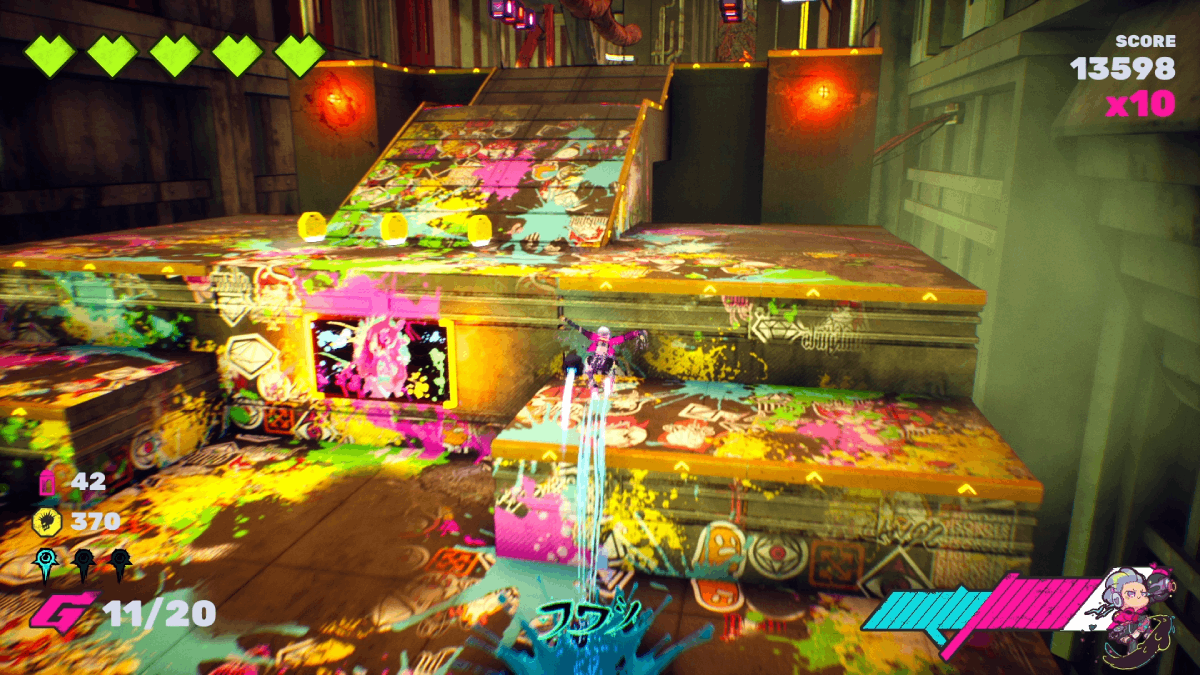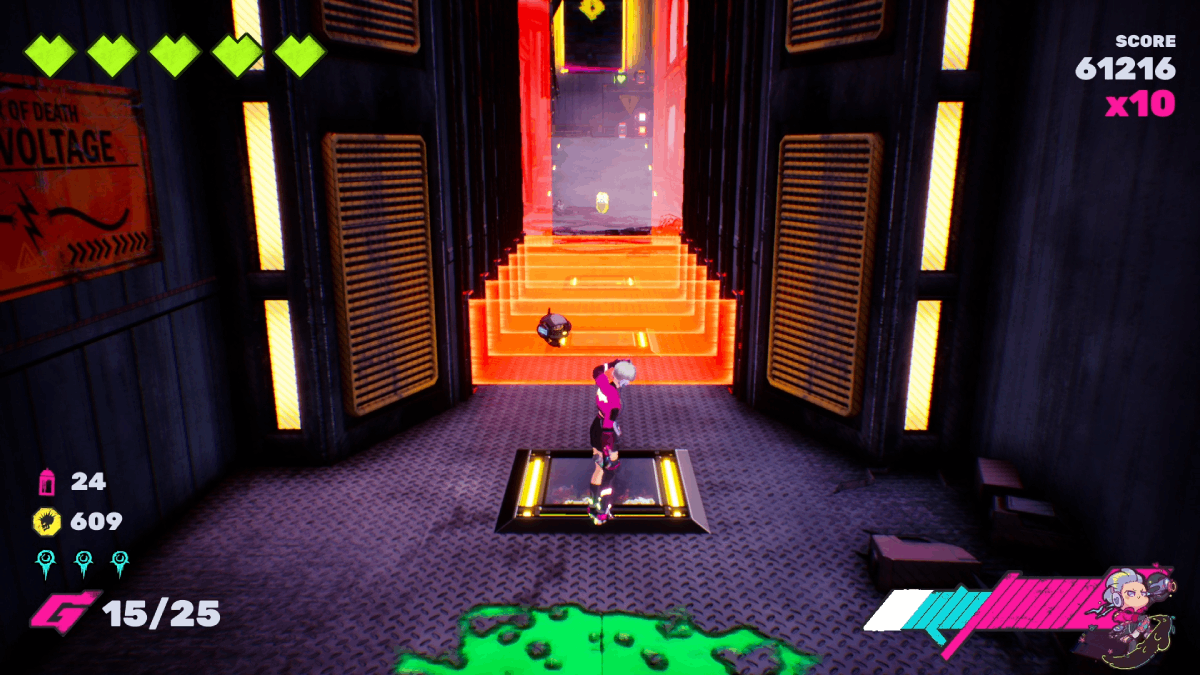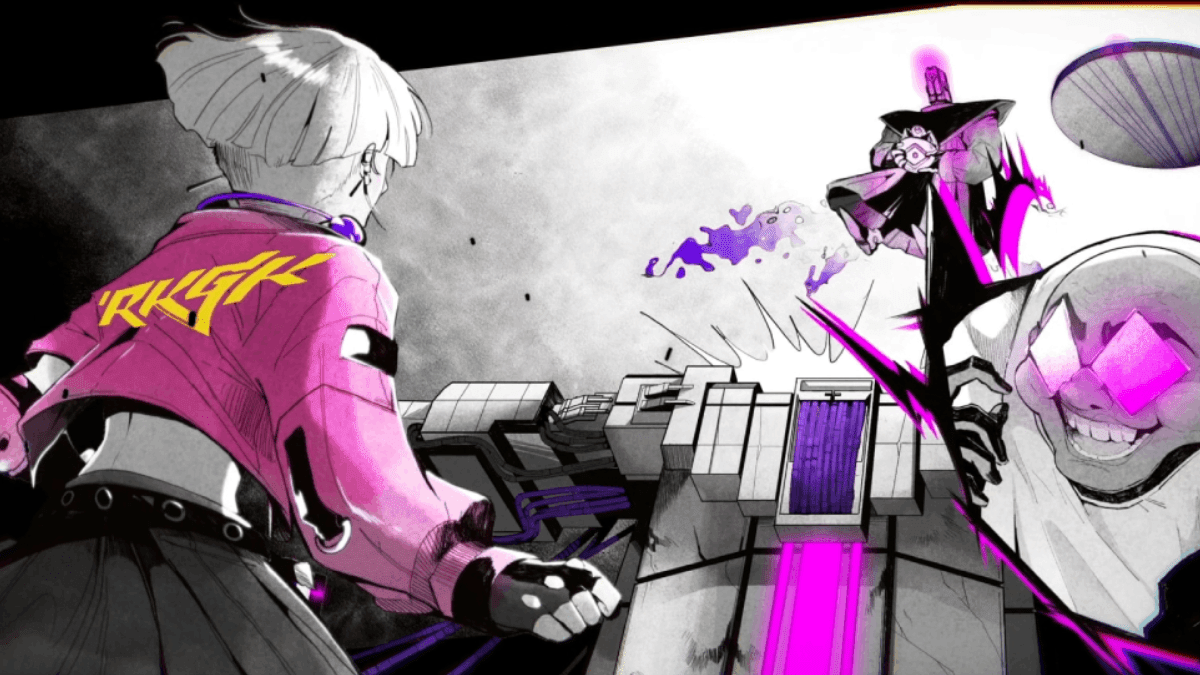Rakugaki, RKGK for short, is here to fill the void in my heart left by the closure of Tango Gameworks. After all, Hi-Fi Rush was one of my favorite games in 2023, so getting another game with similar vibes is welcome.
I’m basing the comparison off little more than both games featuring a protagonist with a rude ‘tude taking on The Man with the power of music. Besides that, there’s not much else in common. RKGK does still unashamedly wear its influences on its sleeve though. In fact, there’s a clear love of classic Sega games here. The movement-based platforming and score system evoke much of the Sonic the Hedgehog franchise, while the emphasis on graffiti brings to mind Jet Set Radio. All that is mixed with a sprinkle of Splatoon paint splatter and Mirror’s Edge parkour thrown into it. The good news is, I love all these things, so we’re off to a great start.
RKGK stars Valah, a graffiti artist living in an unnamed cyberpunk dystopia. After a dictator named Mr Buff covered the city in personality-draining screens, Valah vowed to fight back. Her solution? Tag all the screens and bring color back to the people. She’s aided by her crew, the titular Rakugaki, who provide support from the hideout.
It’s a simple premise, and in fact, so simple you barely need to pay attention to the story. It’s all an excuse plot to get you out there looking cool and literally painting the town red (or blue, or green, or several other customizable color palettes). RKGK is a linear 3D platformer built around fluid movement. As Valah, you jump, dash and skate around the city collecting coins, painting screens and beating up robots.
Each level acts as its own little playground for you to chain moves together. You’ll be skating, grinding, jumping, dashing and gliding all over the place, with the level design encouraging ways to move seamlessly between these actions. Each level drops subtle hints on where you can bypass parts of the geometry to speed up your run. When you start getting into the flow of it all, you’ll find yourself barely touching the ground. It gets addictive fast, and ending one level makes you want to jump straight into the next one.
This is enhanced even further with the presence of Defacer Mode, introduced in the third level. This is activated with a bar at the bottom of the screen that fills up every time you do something cool. Do enough cool things and Valah gets pumped up, increasing her speed and enhancing every ability. Taking damage instantly ends this mode, which creates a sense of tension and challenge. You’ll want to go fast, but going fast increases your chances of bumping into something.

Of course, with the game encouraging speed and fluidity at all times, it doesn’t take long to get to the end credits. I think I managed it within about six hours, breezing my way to the final showdown with ease. However, this short length is a benefit, because the real joy of the game is in its replayability.
RKGK is constantly keeping track of how fast and stylish you are. Time trials, scoreboards and ranks abound, with every level ending with an assessment of your performance. Seeing special time trial challenges and just missing out on the coveted S Ranks only encourages you to play each level again. And again.
RKGK is a game about mastery of the movement system, constantly improving with each attempt. You’ll be seeking out ways to collect as much of the level’s collectibles quickly to boost your score, finding shortcuts to get you to the finish line faster and doing everything in your power to never get hit and keep that Defacer Mode x10 multiplier. S Ranks are not easy to achieve, but I found myself desperately pushing closer and closer to that goal, while having a blast the whole time. If you’re the sort of person who obsessively replays Devil May Cry or 3D Sonic games trying to make a big S slam onto your screen, you will find a lot to love in RKGK.

Sadly, RKGK has some glaring issues that I found hard to ignore. Sadly, its presentation is one of them, which games like this thrive on. Levels are full of nondescript cubes and bland metallic textures. There’s a clear design choice here, as the city is supposed to be miserable. As you skate around, graffiti up the place and amp up the saturation with Defacer Mode, it’s supposed to be a vibrant contrast to show the effects of your actions. It just never quite goes far enough.
Sure, there are some flashes of greatness here, whether it’s in the enemy designs or the way graffiti bleeds out of every defaced screen, but these are small parts of a wider whole that never fully comes together. There are also moments, such as odd volume issues or some of the flat font choices, where it feels like placeholder assets were left in. It’s hard not to compare it to more in-your-face styles like Hi-Fi Rush or Jet Set Radio and think RKGK looks a lot more subdued. Which is one of the worst things a game like this can be.
There’s also a weird disconnect between the game’s main visuals and some of the 2D art kicking around. The occasional motion comics that tells the game’s story all look amazing. The same can be said of the chibi Valah that rides your style meter in Defacer Mode, or the graffiti images that pop when you tag a screen. The 2D artists have done a phenomenal job that hasn’t translated well into most of the 3D assets. Valah has much cooler hair in the motion comics than in gameplay, for instance.

The soundtrack also feels a bit lacking. All the games I’ve mentioned in this review have absurdly catchy soundtracks. Jet Set Radio made Hideki Naganuma one of my favorite video game composers. Hi-Fi Rush had the glorious cafeteria fight set to The Prodigy. Mirror’s Edge has arguably the second best theme song called “Still Alive” in games. By contrast, I’ve forgotten all of RKGK’s basement rave soundtrack, and that’s a shame.
That said, I can forgive most of this. This is the first game for developers Wabisabi Games, and it’s an impressive piece of work for a debut. There’s a clear passion for what the team are doing here and they’ve nailed the gameplay expertly.
If you love mastering movement systems, chasing style ranks or just generally fighting The Man with the power of street art, you need to play RKGK. Its visuals could use some polish but its fluid platforming mechanics are up there with the best.
RKGK is out now for the PC.
8
RKGK / Rakugaki
With creativity, imagination, and spray cans in hand, only you can stand up to Mr. Buff and his army of gray business lackies, restoring life and color to the citizens of Cap City. B Corp and its aesthetics of conformity don’t stand a chance against Valah and the RKGK crew. Steam version reviewed. Review copy provided by company for testing purposes.
While the visuals of RKGK could use some polish, its addictive movement mechanics are up there with some of the best.
Food for Thought
- The Sonic influences go one step further, as the main villain is a rotund man who flies around in machines you continuously defeat.
- Despite the crew being part of the story, they mostly exist to sell you alternate costumes referencing various popular anime.
- You can customize your graffiti but a glitch meant the game chose it entirely randomly from the full pool. Hopefully this is fixed in the final release.

